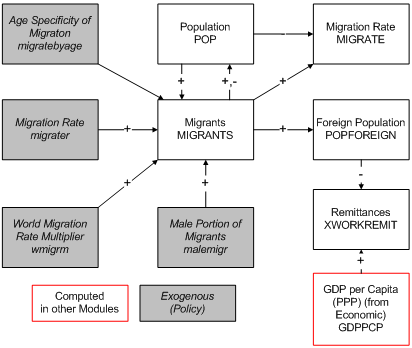International Futures Help System
Migration
Although for most countries it is less important in determining population growth patterns than are fertility and mortality rate, migration is extremely important for some, such as those in the Arabian/Persian Gulf region. Because long-term migration is, however, very difficult to forecast, we rely on exogenous scenarios of migration rate ( migrater ) to drive forecasts in IFs. Users can also affect global migration patterns with a multiplier on global rates ( wmigrm ). On a global basis immigration and emigration are required to balance, and the number of migrants (MIGRANTS) in IFs is balanced, resulting in a computation also of an endogenous migration rate (MIGRATE).

Although data on age and sex of migrants are poor and certainly vary considerably by countries by origin and target, a general representation of the portion of migrants who are male ( malemigr ) is set as a parameter. In addition, the migration rate by age is represented by an internal parameter set, migratebyage , read from a file and not available for users to change via the model interface. As rules of thumb, most migrants are male and disproportionately young adults.
The net of foreign-born population within a country relative to the size of a country’s diaspora abroad (POPFOREIGN) represents the accumulation of the net inflows of migrants over time. That population size and the level of GDP per capita determine the net extent of remittances sent or received from abroad.
 International Futures at the Pardee Center
International Futures at the Pardee Center